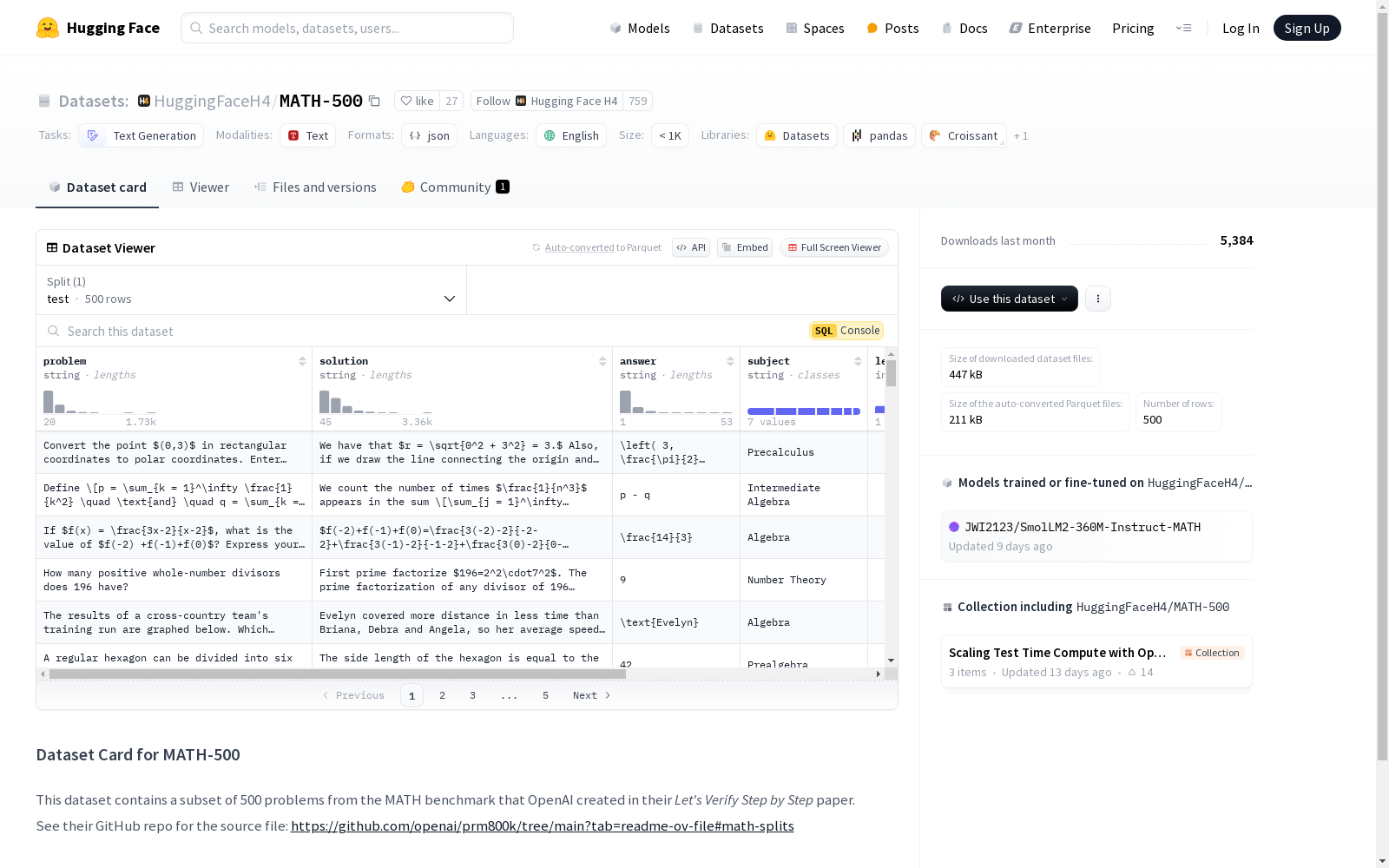MATH-500|数学问题数据集|文本生成数据集
收藏huggingface2024-11-15 更新2024-12-12 收录
下载链接:
https://huggingface.co/datasets/HuggingFaceH4/MATH-500
下载链接
链接失效反馈资源简介:
MATH-500数据集包含500个问题,这些问题是OpenAI在其论文《Let's Verify Step by Step》中创建的MATH基准测试的一部分。数据集的类别是文本生成,语言为英语。
提供机构:
Hugging Face H4
创建时间:
2024-11-15
原始信息汇总
数据集概述
基本信息
- 数据集名称: MATH-500
- 任务类别: 文本生成
- 语言: 英语
数据集描述
该数据集包含从MATH基准测试中选择的500个问题,这些问题是OpenAI在其论文《Lets Verify Step by Step》中创建的。
AI搜集汇总
数据集介绍

构建方式
MATH-500数据集源自OpenAI在其《Let's Verify Step by Step》论文中创建的MATH基准测试,从中精选了500道数学问题。这些问题的选取基于其复杂性和多样性,旨在为文本生成任务提供高质量的数学问题样本。数据集的构建过程严格遵循学术标准,确保了数据的代表性和可靠性。
特点
MATH-500数据集以其高质量和多样性著称,涵盖了广泛的数学领域和难度级别。每个问题都经过精心挑选,以确保其在数学逻辑和解题步骤上的完整性。数据集的语言为英语,适合用于训练和评估文本生成模型,尤其是在数学问题求解方面的表现。
使用方法
MATH-500数据集主要用于文本生成任务,特别是数学问题的自动求解和步骤验证。研究人员和开发者可以通过该数据集训练模型,评估其在数学问题理解和解答上的能力。数据集的使用方法包括加载数据、预处理、模型训练和性能评估,具体操作可参考OpenAI提供的GitHub仓库中的详细指南。
背景与挑战
背景概述
MATH-500数据集源自OpenAI在其论文《Let's Verify Step by Step》中提出的MATH基准测试,旨在推动数学问题求解领域的研究。该数据集由OpenAI团队于2023年创建,包含500道精选数学问题,涵盖了代数、几何、概率等多个数学分支。其核心研究问题在于通过逐步验证的方法,提升模型在复杂数学问题上的推理能力。MATH-500的发布为自然语言处理与数学推理的交叉领域提供了重要的研究资源,推动了相关技术的发展与应用。
当前挑战
MATH-500数据集在解决数学问题生成与推理领域面临多重挑战。首先,数学问题的多样性与复杂性要求模型具备高度的逻辑推理能力,这对现有模型的泛化能力提出了严峻考验。其次,数据集的构建过程中,如何确保问题的代表性、难度分布的合理性以及标注的准确性,是研究人员需要克服的关键问题。此外,逐步验证方法的实现需要精确的步骤分解与逻辑一致性,这对数据集的标注与模型训练提出了更高的技术要求。
常用场景
经典使用场景
MATH-500数据集在自然语言处理领域中被广泛用于文本生成任务,特别是在数学问题求解的自动化系统中。该数据集通过提供500个精心挑选的数学问题,为研究人员提供了一个标准化的测试平台,用于评估和优化文本生成模型在复杂数学推理任务中的表现。
实际应用
在实际应用中,MATH-500数据集被用于开发智能教育工具,如自动解题系统和个性化学习平台。这些工具能够根据学生的解题步骤提供即时反馈,帮助他们更好地理解数学概念,提升学习效率。
衍生相关工作
MATH-500数据集衍生了一系列经典工作,特别是在基于步骤验证的数学问题求解领域。例如,OpenAI的研究团队利用该数据集开发了PRM800K模型,该模型通过逐步验证解题步骤,显著提高了数学问题求解的准确性和可靠性。
以上内容由AI搜集并总结生成
